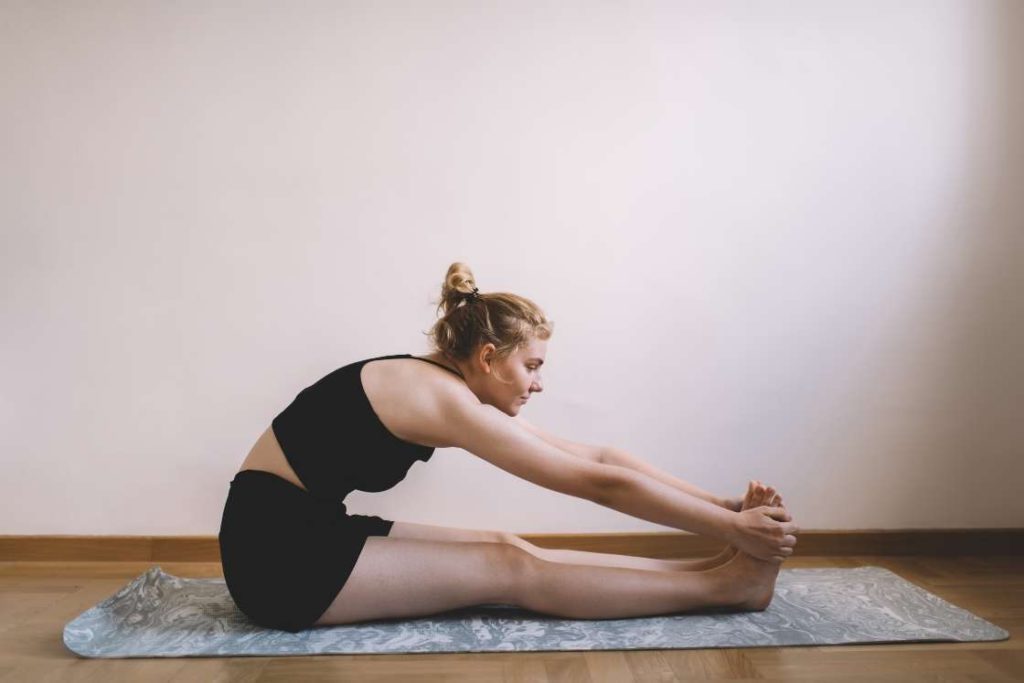
Tadagi Mudra, also known as the “Pond Seal” or “Gesture of the Lake,” is a yoga posture that involves creating a concave shape in the abdomen. This mudra enhances diaphragmatic function, stimulates the digestive system, and improves hamstring flexibility.
It helps release tension in the abdominal and pelvic regions, making it effective for stress reduction and promoting overall well-being. Suitable for both beginners and advanced practitioners, Tadagi Mudra combines mindful breathing with a specific body posture to increase pranic energy flow, harmonizing the body and mind.
Meaning
Tadagi Mudra derives from the Sanskrit words “Tadaga,” meaning “lake” or “pond,” and “Mudra,” meaning “gesture” or “seal.” The practice involves drawing the abdomen inward to form a concave shape, resembling the calm surface of a pond. This posture symbolizes inner stillness and depth, encouraging tranquility and introspection.
Referenced in ancient yogic texts such as the Hatha Yoga Pradipika, Gheranda Samhita, and Shiva Samhita, Tadagi Mudra is recognized for its ritualistic and transformative significance. These texts highlight its role in balancing bodily energies and enhancing overall well-being.
As a kaya mudra, Tadagi Mudra engages the entire body and directs the flow of prana (life energy). It activates the Manipura Chakra in the solar plexus, which helps strengthen the core, improve digestion, and foster relaxation. This practice reflects the serene and balanced qualities of a peaceful pond.
How to do tadagi mudra(steps)
The Tadagi Mudra is a postural mudra that combines elements of both Dandasana (Staff Pose) and Paschimottanasana (Seated Forward Fold). This mudra is characterized by a specific abdominal engagement that transforms the shape of the belly into a barrel-like form. Here’s how to practice it:
- Sit in Dandasana with your legs extended and feet slightly apart, keeping your spine straight.
- Place your hands on your knees and close your eyes.
- Bend forward and grasp your feet with your hands, wrapping your thumbs, index, and middle fingers around them.
- Slightly arch your back by lifting your head and stretching your neck backward.
- Bring your chin to your chest while exhaling.
- Pull your abdominal muscles inward to create a barrel-shaped abdomen, and hold for 10-15 seconds.
- Release the abdominal contraction and return to the starting seated posture.
- Lift your chin and take a deep breath in.
- Repeat the process 10-12 times.
Note: Stay focused while breathing and direct your awareness towards the abdomen and the Manipura (Solar Plexus) Chakra.
Time & Duration
- Ideal Time: The best time to practice Tadagi Mudra is early morning, between 4 am and 6 am, when the mind is clear and focused.
- Duration: Hold the mudra for 10-15 seconds per repetition, repeating 10-12 times per session. Aim for 3-5 rounds daily, with each round lasting 1-2 minutes.
Precautions
- Ensure you do not experience any pain while performing the mudra.
- Avoid straining your breath; practice gentle and controlled breathing.
- If you have spine-related issues, practice under the guidance of a qualified teacher.
- Maintain a relaxed body posture, particularly in the trunk region.
- Practice on an empty stomach to avoid discomfort.
- Release the toes between breaths if needed to adjust and practice comfortably.
Contraindications
- Avoid if you have a hernia or prolapse.
- Not suitable during pregnancy.
- Do not practice if you have severe spine issues or back pain.
- Avoid if you experience discomfort or pain while performing the mudra.
- Refrain from excessive strain on your respiratory system while holding the breath.
- Increased pressure during breath retention for individuals with high blood pressure or cardiovascular issues.
Side effects
Tadagi Mudra typically has minimal side effects when performed correctly. However, some individuals might experience mild discomfort, such as
- Improper technique may cause discomfort in the abdomen.
- Excessive breath retention could lead to strain on the respiratory system.
- Incorrect posture may cause mild back discomfort.
Variation
A slightly easier version of Tadagi Mudra is available. This variation, known as Sulabh Tadagi Mudra (Easy Tadagi Mudra), is performed while lying on your back in a supine position.
How to do sulabh tadagi mudra
- Lie down on your back folding the legs at the knees.
- Take a deep breath in and exhale completely.
- Retain the breath outside (kumbhaka) and close your nostrils with the right hand.
- Expand your rib cage sucking the belly inward.
- Hold the gesture as long as possible.
- Now, relax the ribcage back to normal and then inhale.
- Breathe normally 3-7 times.
Benefits of tadagi mudra
Tadagi Mudra offers significant physical and mental benefits. It improves abdominal circulation, stimulates internal organs, and enhances digestive health. By activating the Manipura Chakra, it supports better energy flow, respiratory function, and helps reduce obesity.
- Tones the abdomen – Expanding, pulling, and relaxing the abdominal muscles while practicing Tadagi Mudra improves blood circulation in the abdomen. It stimulates both the abdominal muscles and internal organs, making it effective for toning the abdominal muscles.
- Relieves physical stress – Performing this mudra stimulates the diaphragm and pelvic floor muscles, helping to release trapped tension in these areas and providing relief.
- Stimulates Visceral Plexus: Tadagi Mudra helps stretch and stimulate the visceral region, which includes the network of nerves in the abdominal area. This stimulation enhances the toning effects on the nerve plexuses, improving the function and health of the internal organs connected to this region.
- Activates Manipura Chakra: Tadagi Mudra exerts pressure on the trunk of the body as it stretches the diaphragm and pelvic floor. This action stimulates the Manipura Chakra, located at the solar plexus, which is the central energy hub in the body. Activating this chakra enhances the flow of prana (vital energy), boosting overall energy levels and promoting a sense of vitality and balance.
- Improves Digestion: Tadagi Mudra helps alleviate stomach-related issues by stimulating digestive juices, enzymes, and hormones. This enhanced stimulation facilitates digestion, which can help address and prevent major digestive health problems.
- Reduces Obesity: Tadagi Mudra is often incorporated into fitness routines to help reduce excess fat and achieve a toned physique. This mudra is effective in targeting and reducing flabby belly fat, making it a useful practice for achieving a flatter stomach.
- Improves Respiratory System: Tadagi Mudra, a kaya mudra that involves deliberate breathing techniques, serves as a gentle exercise for the respiratory organs, particularly the lungs. As a result, it enhances the overall efficiency of the respiratory system.
Conclusion
Tadagi Mudra is a powerful practice that integrates physical, mental, and energetic aspects of wellness. It enhances abdominal blood flow, stimulates internal organs, and supports the balance of the Manipura Chakra.
Incorporating Tadagi Mudra into your daily routine can contribute to a more balanced and healthy lifestyle. Regular practice helps maintain abdominal tone, relieve tension, and promote overall vitality. Embracing this mudra as part of your yoga or wellness regimen can foster long-term well-being and a holistic approach to health.





Pt. 7 and 8 are contradictory. In Pt. 7 , you hv advised to cave in the stomach while inhaling and at the same time, you hv aadvised to kepp tbe stomack Pot like ( Pt. 8). Could you pl clarify.
Namasthe Ashish ji. A very easy to understand explanation of Tadagi mudra. I practice this during my Yoga class. I wanted to know the benefits. Your post here contains appropriate information and is very motivational.